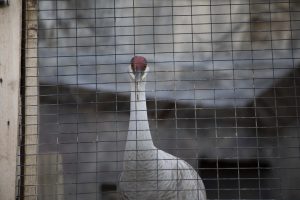Sandhill Crane (Antigone canadensis)
Taxonomy
Kingdom: Animalia
Phylum: Chordata
Class: Aves
Order: Gruiformes
Family: Gruidae
Genus: Antigone
Species: Antigone canadensis
Conservation Status in Idaho
Rare or uncommon but not imperiled, breeding population
US Migratory Bird Act
Protected
Range and Habitat
Sandhill cranes are found throughout Canada, the United States, and northern Mexico. Sandhill cranes will breed as far north and Alaska, the Arctic coast of Canada, the Great Lakes region and into Idaho, Nevada and Oregon. The winter range includes California, Arizona, New Mexico, Texas, and northern Mexico. Populations in southeastern United States and Cuba do not migrate. Sandhill cranes live in open habitats, small bogs, marshes, wetlands, river basins, and prairies.
Physical Features
Weight: 7.0–11.5 lbs (3.2–5.2 kg)
Length: Up to 4 ft (1.2 m)
Wingspan: 6.6 ft (2 m)
Sandhill cranes are large, tall birds with long legs and neck, and broad wings. The head is small with a long straight bill. They are slate gray birds with a rusty wash on the upper wings and “bustle,” drooping feathers covering the tail. Adults have white cheeks with a red crown. Sub-adults are gray and rusty brown without the adult coloration.
Diet
Omnivorous, feeding on berries, seeds, small mammals, insects, snails, reptiles, and amphibians.
Lifespan
21 years in the wild and slightly longer in captivity.
Reproduction
Sandhill cranes are monogamous with pairs remaining together from year to year. Breeding pairs form during spring migration and are maintained by performing courtship displays, remaining in close proximity, and calling together in unison. Five courtship displays have been identified: upright wing stretch, horizontal head pump, bow, vertical leap, and vertical toss. Three additional displays are used exclusively by paired adults: bill up, copulation, and unison call. Migratory sandhill cranes begin to lay eggs early April-May while non-migratory cranes may begin as early as December and as late as August. They will raise one brood per year while laying one – three eggs with two being common. Both parents are active in the incubating and rearing of the chicks. Incubation lasts 29-32 days and the chicks reach independence in nine to ten months. The sub-adults form independent flocks with other sub-adults and non-breeders. Sandhill cranes begin to breed between two to seven years of age.
Social Behavior and Interaction
Cranes are typically found in pairs or family groups. During migration and on wintering grounds (northern populations) groups will join with non-mated cranes to form extremely large flocks, into the tens of thousands. Sandhill cranes are diurnal.
Major Threats
Loss of wetland habitats, staging and overwintering areas, and urbanization.

